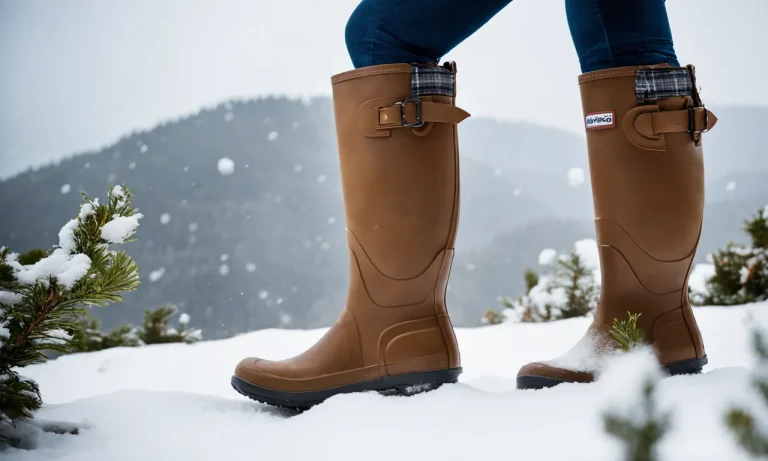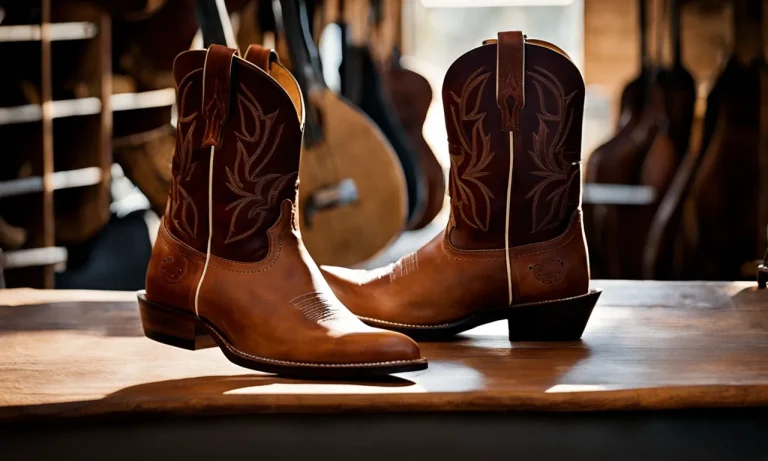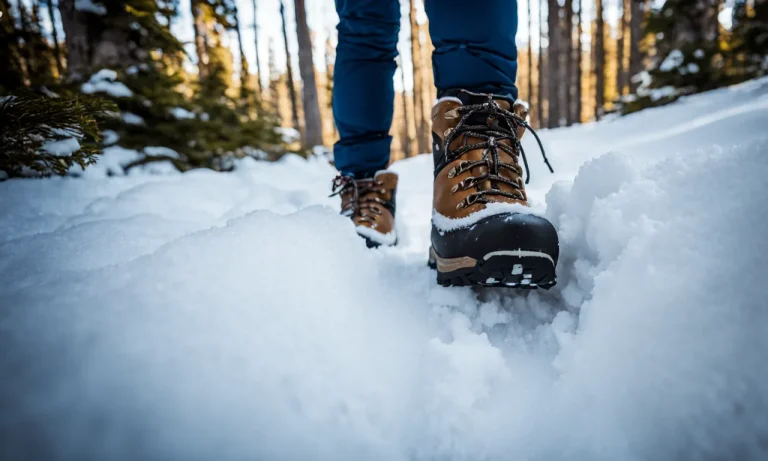For members of the U.S. Army’s elite 75th Ranger Regiment, having the right footwear can make all the difference during demanding training and operations. If you’re wondering what boots army rangers wear, this comprehensive guide will provide all the details.
If you’re short on time, here’s a quick answer: Army rangers typically wear lightweight, durable boots from brands like Nike, Oakley, Danner, and Belleville. Models like the Nike SFB, Oakley Light Assault, Danner Rivot TFX, and Belleville One Xero are popular choices.
Background on Army Rangers
The Army Rangers are an elite special operations force within the United States Army. They are known for their exceptional skills in direct action, special reconnaissance, and counterterrorism operations. Rangers undergo rigorous training and are highly skilled in various combat techniques.
Overview and history of army rangers
The Army Rangers have a rich history dating back to World War II, where they were initially formed as a specialized unit to conduct high-risk missions behind enemy lines. Over the years, the Rangers have evolved and adapted to the changing nature of warfare, becoming one of the most respected and effective fighting forces in the world.
Today, the 75th Ranger Regiment is the primary Ranger unit in the U.S. Army. They are based at Fort Benning, Georgia, and consist of three battalions specializing in different areas of operation.
Training and mission profile
Ranger training is known to be one of the toughest in the military. Candidates must pass a series of physically and mentally demanding tests, including the Ranger Assessment and Selection Program (RASP) and the Ranger School.
These tests assess an individual’s ability to operate in high-stress environments, make quick decisions, and demonstrate exceptional physical fitness.
Once selected, Rangers are trained in various combat tactics, including airborne operations, marksmanship, close-quarters combat, and mission planning. They are also proficient in land navigation, survival, and medical skills.
Rangers are often deployed in small, highly specialized teams and are tasked with conducting a wide range of missions. These can include direct action raids, special reconnaissance, hostage rescue, and counterterrorism operations.
Their ability to operate in any environment, from dense jungles to arid deserts, makes them a versatile force capable of executing complex missions.
Key boot requirements and preferences
Given the demanding nature of their operations, Army Rangers require footwear that provides exceptional durability, comfort, and protection. Their boots must be able to withstand harsh terrains, extreme temperatures, and long hours of wear.
Rangers often opt for specialized combat boots that offer superior ankle support and protection. These boots are designed to reduce the risk of injuries during strenuous activities, such as fast roping, rappelling, and long-distance marches.
While there is no specific brand or model of boots mandated for Rangers, there are certain features that are highly preferred. These include waterproofing capabilities, slip-resistant soles, and lightweight construction for improved mobility.
Additionally, boots with breathable materials and moisture-wicking properties help keep the feet dry and comfortable in varying weather conditions.
Rangers also prioritize boots that are compatible with their specific mission requirements. For example, if they anticipate conducting waterborne operations, they may opt for boots that dry quickly and drain water efficiently.
It’s worth noting that personal preferences can vary among Rangers, and some may choose to use different boots based on their individual needs and experiences. Ultimately, the goal is to select footwear that offers the best combination of functionality, comfort, and durability to support the demanding tasks performed by Army Rangers.
Popular Ranger Boot Models
Nike SFB
The Nike SFB (Special Field Boot) is one of the most popular boot models worn by Army Rangers. Designed specifically for tactical use, the Nike SFB offers excellent durability and comfort. Its lightweight construction allows for maximum mobility, while the durable upper provides protection against abrasions and other hazards.
The Nike SFB also features a cushioned midsole for added support and a rubber outsole for superior traction on various terrains. With its sleek design and reliable performance, it’s no wonder why many Army Rangers choose the Nike SFB as their go-to boot.
Oakley Light Assault Boot
The Oakley Light Assault Boot is another favored choice among Army Rangers. Known for its exceptional performance in rugged environments, this boot offers both comfort and durability. The Oakley Light Assault Boot features a lightweight design and a breathable upper, allowing for enhanced ventilation during long missions.
Additionally, its slip-resistant outsole ensures stability and traction on different surfaces. Whether climbing steep hills or traversing through muddy terrain, the Oakley Light Assault Boot provides the necessary support and protection.
Danner Rivot TFX
The Danner Rivot TFX (Tactical Footwear Extreme) is a high-quality boot model that has gained popularity among Army Rangers. Built to withstand the toughest conditions, the Danner Rivot TFX offers maximum protection and comfort.
It features a full-grain leather and nylon upper, providing durability and flexibility. The boot also incorporates a Vibram outsole for superior traction and a cushioned footbed for added support. With its advanced technology and reliable performance, the Danner Rivot TFX is a top choice for Army Rangers.
Belleville One Xero
The Belleville One Xero is a lightweight and versatile boot model that is highly favored by Army Rangers. Made with a combination of leather and nylon, this boot offers both durability and breathability.
The Belleville One Xero features a Vibram sole for excellent traction and a cushioned insole for enhanced comfort. Its minimalist design allows for quick and easy movement, making it suitable for various tactical operations.
Whether trekking through rugged terrains or engaging in combat situations, the Belleville One Xero provides the necessary support and agility.
Key Boot Features for Rangers
Lightweight
One of the key features that Army Rangers look for in their footwear is lightweight. Rangers are often required to cover long distances on foot, sometimes in challenging terrains. Wearing heavy boots can quickly tire them out and hinder their performance.
Lightweight boots allow for better mobility and reduce fatigue, enabling Rangers to move swiftly and efficiently.
Ankle Support
Another crucial feature in Ranger boots is ankle support. Rangers often operate in rugged and uneven terrains, which can put a strain on their ankles. Boots with proper ankle support help prevent sprains and injuries, providing stability and protection.
High-cut boots that extend above the ankle provide extra support and stability, especially during strenuous activities and combat situations.
Drainage and Ventilation
Ranger boots are designed to withstand various weather conditions and environments. Whether they are navigating through wetlands, crossing rivers, or trekking in hot climates, boots with drainage and ventilation capabilities are essential.
These features allow water to escape and air to circulate, preventing the buildup of moisture and enhancing comfort. Proper drainage and ventilation help keep the feet dry, reducing the risk of blisters, fungal infections, and other foot-related issues.
Durability
Durability is a must-have feature for Ranger boots. Army Rangers engage in demanding and physically challenging tasks, often in harsh environments. Their boots need to withstand rough terrain, extreme temperatures, and potential impacts.
Boots made from high-quality materials, reinforced with sturdy construction, can endure the rigors of Ranger operations. Durability ensures that the boots remain reliable and intact even after prolonged use.
Traction
Having excellent traction is vital for Army Rangers. They operate in various terrains, including slippery surfaces, loose gravel, and muddy areas. Boots with reliable traction provide grip and stability, reducing the risk of slipping and falling.
Deep lugs on the outsole, specialized rubber compounds, and innovative tread patterns are some features that enhance traction, allowing Rangers to navigate challenging terrains with confidence.
How Rangers Select and Customize Boots
When it comes to selecting and customizing their boots, Army Rangers go through a rigorous process to ensure they have the right footwear for the job. Here are some key factors that Rangers consider:
Field testing
Rangers understand that their boots are a vital piece of equipment that can make or break their performance in the field. Before selecting a particular boot, they often engage in extensive field testing to assess its durability, comfort, and performance in various conditions.
This involves wearing the boots during long hikes, challenging terrains, and even simulated combat exercises. By doing so, Rangers can evaluate how the boots hold up and if they meet their specific needs.
During field testing, Rangers pay close attention to factors such as traction, ankle support, waterproofing, and breathability. These are crucial considerations, as they directly impact the Ranger’s ability to navigate through different environments and maintain optimal foot health.
By thoroughly testing different boots, Rangers can identify which ones perform best under specific circumstances.
Aftermarket insoles and modifications
Rangers often customize their boots with aftermarket insoles and modifications to enhance comfort and performance. One of the most common modifications is replacing the stock insoles with specialized ones that offer better arch support, cushioning, and moisture-wicking properties.
These aftermarket insoles help reduce foot fatigue and prevent common foot problems that can arise during extended periods of wear.
In addition to insoles, Rangers may also make other modifications to their boots, such as adding additional padding, reinforcing the toe cap, or adjusting the lacing system for a more secure fit. These modifications are often based on the individual Ranger’s personal preferences and specific requirements.
It is important to note that while customization is common among Rangers, they must adhere to certain guidelines and regulations set by the military. These guidelines ensure that any modifications made to the boots do not compromise their safety or functionality.
For more information on Army Ranger boots and their selection process, you can visit the official website of the U.S. Army at www.army.mil.
Ranger Boot Regulations and Supply
Authorized Boots
Army Rangers are required to wear specific boots that meet the rigorous demands of their job. The boots must comply with the regulations set forth by the U.S. Army. The authorized boots for Army Rangers are designed to provide durability, protection, and comfort in a variety of environments.
One of the most commonly used boots by Army Rangers is the Belleville 390 DES. This boot features a rugged leather exterior, a Vibram outsole for superior traction, and a Gore-Tex lining for waterproof protection.
The Belleville 390 DES is known for its durability and ability to withstand harsh conditions.
Another popular choice among Army Rangers is the Danner Tachyon. This lightweight boot offers excellent flexibility and breathability, making it suitable for extended periods of wear. The Danner Tachyon also features a rubber outsole for enhanced traction and an EVA midsole for cushioning and support.
It’s important to note that Army Rangers have specific guidelines on the color of boots they can wear. Typically, the authorized colors for boots are coyote brown or tan. These colors help to blend in with the natural surroundings and provide a tactical advantage in the field.
Availability through Supply Chain
Army Rangers can obtain their authorized boots through the military supply chain. The supply chain ensures that soldiers have access to the necessary equipment and gear required for their mission.
Boots are typically issued to Army Rangers during their initial training and throughout their service. The supply chain ensures that the boots meet the required specifications and are readily available for replacement when needed.
In addition to the supply chain, Army Rangers can also purchase authorized boots from authorized vendors. These vendors are certified by the military and offer a variety of boots that meet the required standards. This allows Army Rangers to have more options when it comes to selecting their footwear.
It’s important for Army Rangers to regularly inspect their boots for wear and tear and replace them when necessary. Properly maintained and fitted boots are crucial for the safety and performance of Army Rangers in the field.
For more information on Army Ranger boot regulations and supply, you can visit the official U.S. Army website at www.army.mil.
Conclusion
For army rangers operating at an elite level, having properly fitted, high performance footwear can enhance comfort, prevent injury, and provide a critical edge during missions. While they have some flexibility to pick their boots, popular choices tend to prioritize lightweight construction, ankle support, drainage, traction, and durability.
By understanding rangers’ demanding needs and preferences, we hope this guide has shed light on what boots they rely on for peak operational readiness.






